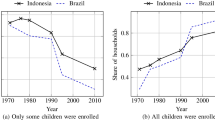Abstract
The interaction between investment in children’s education and parental fertility is crucial in recent theories of the transition from Malthusian stagnation to modern economic growth. This paper contributes to the literature on the child quantity–quality trade-off with new county-level evidence for Prussia in 1816, several decades before the demographic transition. We find a significant negative causal effect of education on fertility, which is robust to accounting for spatial autocorrelation. The causal effect of education is identified through exogenous variation in enrollment rates due to differences in landownership inequality. A comparison with estimates for 1849 suggests that the preference for quality relative to quantity might have increased during the first half of the nineteenth century.


Similar content being viewed by others
Notes
Recently, Klemp and Weisdorf (2010) estimate the causal effect of fertility on literacy using the Cambridge Group’s demographic data for 26 English parishes for the 17th and 18th century. They identify the causal effect of fertility on literacy using exogenous variation in sibship size due to differences in parental fecundity.
See also Clark (2007) for a controversial evolutionary explanation of why England was the first to industrialize.
The model of Galor and Moav (2002) discusses both genetic and cultural evolution. We do not consider the genetic mechanism given the relatively short time period for which we can perform a comparative analysis, 1816–1849.
Additionally, we drop two observations, namely the counties of Adenau and Stadtkreis Trier, because of implausible low values of the female adult population. Regression results including these two observations are basically identical.
We consider as primary schools both elementary schools (Elementarschulen) and middle schools (Mittelschulen).
This is because technological progress reduces the adaptability of existing human capital to the new technological environment.
A Prussian Morgen was equal to about 0.25 hectares.
Following Becker and Woessmann (2009, 2010), we also used distance to Wittenberg as an alternative instrument for education in 1816, exploiting the fact that Martin Luther had preached his followers to learn to read in order to read the Bible. Results are qualitatively the same when using that instrument. Detailed results are available from the authors on request.
Latitude and longitude are expressed in decimal degrees. We assigned a distance threshold value of one degree which corresponds to approximately 111 km at the equator. The largest minimum distance is 0.90 degrees, which means that if we specify a threshold value smaller than 0.90, there is at least one county with no neighbors. The spatial regression results discussed are robust to different specifications of the distance threshold value.
Detailed results of the tests of spatial dependence are available upon request.
Given the issues related to county border changes for the data on births 1816-21, the spatial analysis considers only the child–woman ratio in 1816 as a dependent variable.
When increasing the distance threshold value, results obtained through OLS and spatial regressions tend to converge.
The ceteris paribus condition includes the assumption that the cost of raising a child (regardless of quality) and the cost of educating a child did not change between 1816 and 1849.
Further evidence in Becker et al. (2010b) suggests that higher female education may have additionally led to reduced fertility in the next generation.
References
Anselin L (1988) Spatial econometrics: methods and models. Kluwer Academic Publishers, Dordrecht
Anselin L, Hudak S (1992) Spatial econometrics in practice: a review of software options. Reg Sci Urban Econ 22:509–536
Becker SO, Woessmann L (2008) Luther and the girls: religious denomination and the female education gap in 19th Century Prussia. Scand J Econ 110:777–805
Becker SO, Woessmann L (2009) Was Weber wrong? A human capital theory of Protestant economic history. Quart J Econ 124:531–596
Becker SO, Woessmann L (2010) The effect of Protestantism on education before the industrialization: evidence from 1816 Prussia. Econ Lett 107:224–228
Becker SO, Cinnirella F, Woessmann L (2010a) The trade-off between fertility and education: evidence from before the demographic transition. J Econ Growth 15:177–204
Becker SO, Cinnirella F, Woessmann L (2010b) Does parental education affect fertility? Evidence from pre-demographic transition Prussia. Mimeo
Becker SO, Hornung E, Woessmann L (2010c) Education and catch-up in the industrial revolution. Am Econ J Macroecon (forthcoming)
Bengtsson T, Dribe M (2006) Deliberate control in a natural fertility population: Southern Sweden, 1766–1864. Demography 43:727–746
Bleakley H, Lange F (2009) Chronic disease burden and the interaction of education, fertility, and growth. Rev Econ Stat 91:52–65
Boyer GR, Williamson JG (1989) A quantitative assessment of the fertility transition in England, 1851–1911. Res Econ Hist 12:93–117
Brown JC, Guinnane TW (2002) Fertility transition in a rural, catholic population: Bavaria, 1880–1910. Popul Stud 56:35–49
Brown JC, Guinnane TW (2007) Regions and time in the European fertility transition: problems in the Princeton project’s statistical methodology. Econ Hist Rev 60:574–595
Cervellati M, Sunde U (2005) Human capital formation, life expectancy, and the process of development. Am Econ Rev 95:1653–1672
Cervellati M, Sunde U (2007) Human capital, mortality and fertility: a unified theory of the economic and demographic transition. CEPR Discussion Paper 6384
Chi G, Zhu J (2008) Spatial regression models for demographic analysis. Popul Res Policy Rev 27:17–42
Clark G (2007) A farewell to alms: a brief economic history of the world. Princeton University Press, Princeton
Coale AJ, Watkins SC (1986) The decline of fertility in Europe. Princeton University Press, Princeton
Crafts NFR (1989) Duration of marriage, fertility and women’s employment opportunities in England and Wales in 1911. Popul Stud 43:325–335
Doepke M (2005) Child mortality and fertility decline: does the Barro-Becker model fit the facts? J Popul Econ 18:337–366
Galloway PR, Hammel EA, Lee RD (1994) Fertility decline in Prussia, 1875–1910: a pooled cross-section time series analysis. Popul Stud 48:135–158
Galloway PR, Lee RD, Hammel EA (1998) Urban versus rural: fertility decline in the cities and rural districts of Prussia, 1875 to 1910. Eur J Popul 14:209–264
Galor O (2005a) The demographic transition and the emergence of sustained economic growth. J Eur Econ Assoc 3:494–504
Galor O (2005b) From stagnation to growth: unified growth theory. In: Handbook of economic growth, vol 1A. Elsevier, Amsterdam
Galor O, Moav O (2002) Natural selection and the origin of economic growth. Quart J Econ 117:1133–1191
Galor O, Moav O (2005) Natural selection and the evolution of life expectancy. CEPR Discussion Paper 5373
Galor O, Weil DN (1999) From Malthusian stagnation to modern growth. Am Econ Rev 89:150–154
Galor O, Moav O, Vollrath D (2009) Inequality in land ownership, the emergence of human-capital promoting institutions and the great divergence. Rev Econ Stud 76:143–179
Klemp MPB, Weisdorf JL (2010) The child quantity-quality trade-off: evidence from the population history of England. University of Copenhagen, Copenhagen Mimeo
Knodel JE (1974) The decline of fertility in Germany, 1871–1939. Princeton University Press, Princeton
Lee R (2003) The demographic transition: three centuries of fundamental change. J Econ Perspect 17:167–190
Melton JVH (1988) Absolutism and the eighteenth-century origins of compulsory schooling in Prussia and Austria. Cambridge University Press, Cambridge
Schultz TP (2008) Population policies, fertility, women’s human capital, and child quality. In: Handbook of development economics, vol 4, chap. 52. Elsevier, Amsterdam, pp 3249–3303
Acknowledgments
Comments from two anonymous referees and financial support by the Pact for Research and Innovation of the Leibniz Association are gratefully acknowledged.
Author information
Authors and Affiliations
Corresponding author
Rights and permissions
About this article
Cite this article
Becker, S.O., Cinnirella, F. & Woessmann, L. The effect of investment in children’s education on fertility in 1816 Prussia. Cliometrica 6, 29–44 (2012). https://doi.org/10.1007/s11698-011-0061-8
Received:
Accepted:
Published:
Issue Date:
DOI: https://doi.org/10.1007/s11698-011-0061-8




